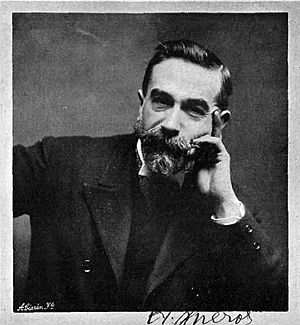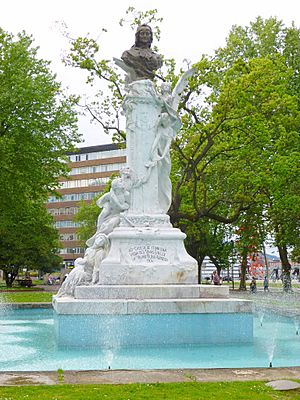Agustí Querol Subirats facts for kids
Quick facts for kids
Agustí Querol
|
|
|---|---|

Photograph by Kaulak
|
|
| Born |
Agustí Querol Subirats
17 May 1860 |
| Died | 14 December 1909 (aged 49) |
| Nationality | Spanish |
| Occupation | sculptor, politician |
| Years active | member of the Congress of Deputies (1907, 1909) |
|
Notable work
|
|
Agustí Querol i Subirats (born May 17, 1860 – died December 14, 1909) was a famous Spanish sculptor. He was born in Tortosa, Catalonia, Spain.
Contents
Life of Agustí Querol
Agustí Querol grew up in a family that didn't have much money. His father was a baker. Agustí learned from a teacher named Ramon Cerveto Bestraten.
Early Life and Training
When he was 18, Agustí left his father's bakery. He moved to Barcelona to follow his dream of becoming an artist. There, he worked as an apprentice (a student who learns by working) in the studios of famous sculptors. He learned from Domingo Talarn and the Vallmitjana Brothers.
Agustí also took sculpture classes at a school called "la Llotja." He even studied dissection and anatomy at a hospital. This helped him understand the human body better for his sculptures. Later, he won a special scholarship to study art in Rome, Italy.
Moving to Madrid and His Style
From 1890, Agustí lived in Madrid. He became very busy, creating many monuments and sculptures. His art was known for its romantic style. His sculptures had lots of detail and looked very lively.
For example, the front of the Biblioteca Nacional de España (National Library of Spain) has 19 different figures he sculpted. All his big projects were full of action and detail.
Querol's Studio and Other Interests
Agustí Querol had a large art studio. Many young artists learned from him, like Lorenzo Coullaut Valera. He also worked as a businessman, selling Carrara marble. This is a special type of stone used for sculptures.
He was involved in art shows and even wrote stories. He used the pen name El Plutarco del Pueblo, which means "The People's Plutarch." Agustí was also the vice-director of the Museo de Arte Moderno de Madrid for a few years. He even became a politician, serving as a deputy (a type of representative) in the Spanish government.
Agustí Querol died in Madrid and is buried there.
Unfinished Works and Legacy
When Agustí passed away, he left some monuments unfinished. These were in places like Tortosa, Buenos Aires, Guayaquil, and Montevideo. Other artists helped finish them later.
One famous example is the Monument De los Españoles' in Buenos Aires, Argentina. This huge monument has a statue of Liberty, a large carved frieze, and bronze figures. It was a very complex project. It faced many delays, including a ship sinking in 1916 with some of the finished sculptures on board! The monument was finally completed in 1927.
Famous Works by Agustí Querol
Agustí Querol created many important sculptures and monuments. Here are some of his well-known works:
- Finial figure of Spain with lion: This sculpture sits on top of the Biblioteca Nacional de España in Madrid (1892–1903).
- Guirao Pantheon mausoleum: A large tomb at San Isidro Cemetery in Madrid (1908-1911), finished after he died.
- Monument to explorers Legazpi and Urdaneta: This monument was first in Madrid, then moved to Manila (1890s).
- Monument to Firemen: Located in Colon Cemetery, Havana, Cuba (1897).
- Monument to Claudio Moyano: Found in the Plaza del Emperador Carlos V in Madrid (1900).
- Monument to Francisco de Quevedo: Located at Glorieta de Quevedo in Madrid (1902).
- Monument to the Martyrs of the Plaza of Spain: In Zaragoza, Spain (1904).
- White marble mausoleum of Antonio Cánovas del Castillo: At the Pantheon of Illustrious Men in Madrid (1906).
- Statue of Frederic Soler i Hubert: On La Rambla, Barcelona (1906).
- Monument to Casilda Iturrizar: In Doña Casilda Iturrizar park in Bilbao (1906).
- La Gloria y los Pegasos sculptural groups: These included a group called Science, Art, and Glory and two large Pegasus figures. They were originally on top of the Spanish Ministry of Agriculture in Madrid (1905).
- Monument to the Siege of Zaragoza: In Zaragoza (1908).
- Monument to Segismundo Moret: In Cádiz (1909).
- Tower monument and bronze fountain figures at the Monument De los Españoles': Also known as Monument to the Magna Carta, in Buenos Aires, Argentina. He designed it in 1909, and it was finished in 1927.
- Four pegasus-with-riders sculptures: These are on the roof of the Palacio de Bellas Artes in Mexico City.
Images for kids
-
Pegasus and figure, atop the Spanish Ministry of Agriculture, Madrid
-
Finial figure of Spain with circular garland, atop the Biblioteca Nacional de España, Madrid, 1892-1903
-
Statue of Segismundo Moret at Cádiz, Andalucía
-
Memorial to Alfonso XII of Spain
See also
 In Spanish: Agustín Querol para niños
In Spanish: Agustín Querol para niños






